2015 MERCEDES-BENZ SLS AMG GT ROADSTER fuel
[x] Cancel search: fuelPage 197 of 290

Engine
Problem
Possible causes/consequences and
0050
0050Solutions 00B9
The yellow
CheckEngine
warning lamp
light supw hile
th ee ngineis
running. Ther
emay be amalfunction, for example:
R in th eenginem anagement
R in th efuel injection system
R in th eexhaust system
R in th eignition system
R in th efuel system
The emission limit values may be exceeded and th eenginem ay be
in emergency mode.
X Hav ethe vehicle checked as soon as possible at aqualified
specialist workshop.
i In som
estates, you must visi taqualifie dspecialist workshop
as soon as th eyellow check engin ewarning lamp light sup. This
is due to th elegal requirements in effect in these states. If in
doubt ,che ck whether suc hlegal regulations apply in th estate in
whic hyou are currently driving. 00B9
The yellow
CheckEngine
warning lamp
light supw hile
th ee ngineis
running. The
smoothness of
th eg ear change
is restricted. The sub geartrain with th
eodd gear shas failed .The transmission
is in emergency mode.
X Hav ethe vehicle checked as soon as possible at aqualified
specialist workshop. 00E4
The red engine
oil temperature
warning lamp
comes on while
thee ngineis
running. Awarn-
ing tone also
sounds. The engin
eoil temperatur ehas exceeded 28 4‡(140† ).
The engin eisnotbein gcooled sufficiently and may be damaged.
X Pull ove rand stop th evehicle safely and switch off th eengine,
paying attentio ntoroad and traffic conditions.
X Allo wthe engin etoc ooldown. Warning and indicator lamps in th
einstrumen tcluster
195On-boar dcomputer and displays Z
Page 198 of 290
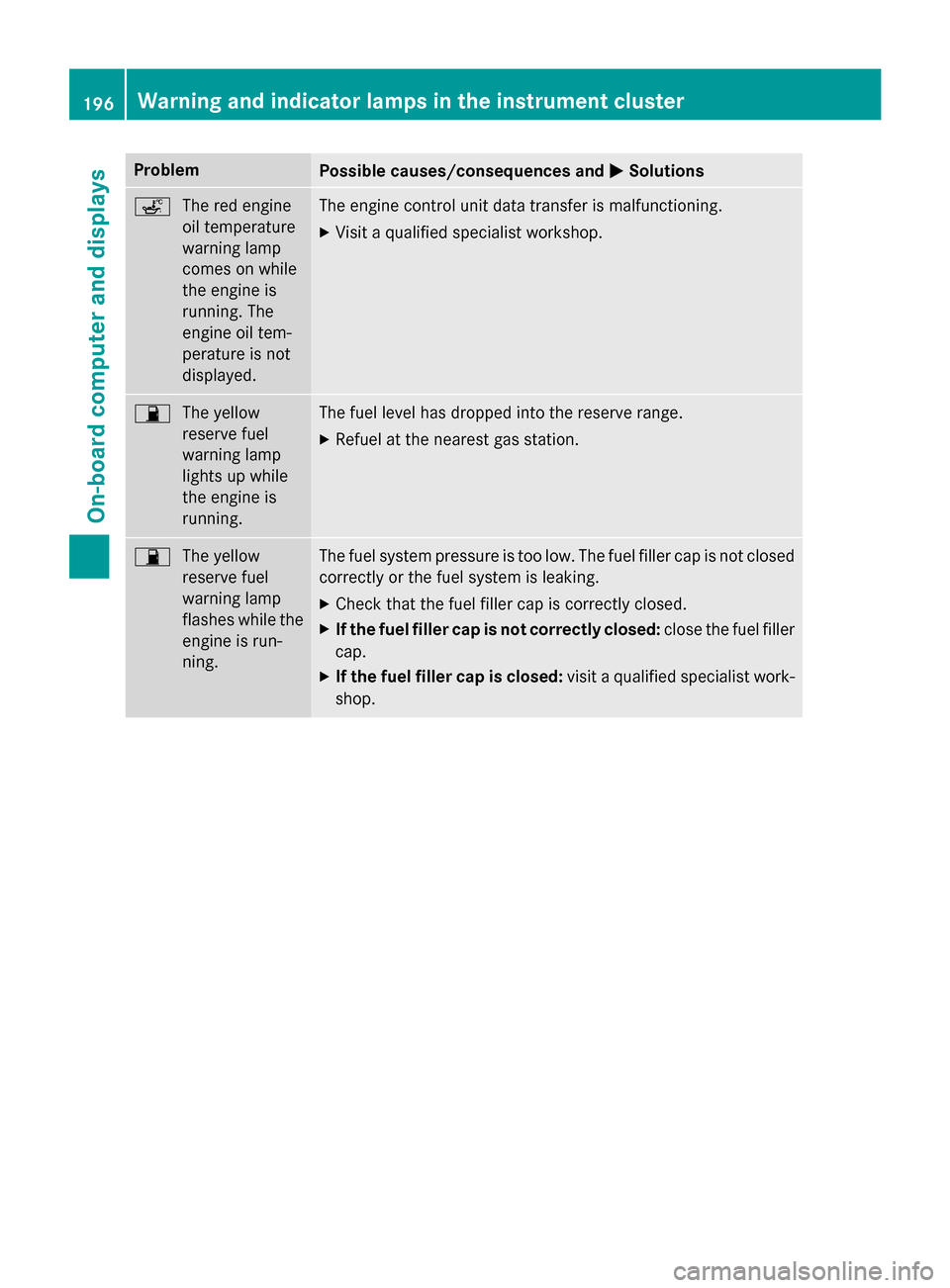
Problem
Possible causes/consequences and
0050
0050Solutions 00E4
The red engine
oil temperature
warning lamp
comes on while
the engine is
running. The
engine oil tem-
perature is not
displayed. The engine control unit data transfer is malfunctioning.
X Visit aqualified specialist workshop. 00B5
The yellow
reserve fuel
warning lamp
lights up while
the engine is
running. The fuel level has dropped into the reserve range.
X Refuel at the nearest gas station. 00B5
The yellow
reserve fuel
warning lamp
flashes while the
engine is run-
ning. The fuel system pressure is too low. The fuel filler cap is not closed
correctly or the fuel system is leaking.
X Check that the fuel filler cap is correctly closed.
X If the fuel filler cap is not correctly closed: close the fuel filler
cap.
X If the fuel filler cap is closed: visitaqualified specialist work-
shop. 196
Warning and indicator lampsint
he instrument clusterOn-board computer and displays
Page 228 of 290

X
Remove coolant, brak efluid ,tre er esin,
oils ,fuel sand greases by rubbin ggently
wit hac loth soaked in petroleum ether or
lighte rfluid.
X Use tar remove rtoremove tar stains.
X Use silicon eremove rtoremove wax.
! Do no
taffix:
R stickers
R films
R magneti cplates or similar items
to painte dsurfaces. You could otherwise
damag ethe paintwork.
If water no longer forms "beads "onthe paint
surface, use th epaintcarep roducts recom-
mended and approve dbyMercedes-Benz.
This is th ecasea pproximately every three to
fiv em onths, dependin gontheclimat econ-
dition sand th ecarep roduc tused.
If dir thas penetrated th epaintsurfac eort he
pain thas become dull, th epaintcleane rrec-
ommended and approve dbyMercedes-Benz
should be used.
Do no tuse these car eproducts in th esun or
on th ehoodw hile th ehoodish ot.
X Use asuitable touch-up stick ,e.g.MB
Touch-Up Stick ,toc orrect smaller area sof
pain tdamag equickl yand provisionally.
Matt efinish care If your vehicl
ehasac lear matte finish,
observ ethe followin ginstructions in order to
avoid damag etothepaintwork due to incor-
rec tcare.
These note salso apply to ligh talloy wheels
wit hac lear matte finish.
! Never polis
hthe vehicl eortheligh talloy
wheels. Polishing causes th efinish to
shine. !
The followin
gmay caus ethe pain tto
become shiny and thus reduce th ematte
effect:
R Vigorous rubbin gwithu nsuitable mate-
rials.
R Frequen tuse of car washes.
R Washin gthe vehicl eindirectsunlight.
! Never use pain
tcleaner, buffin gorpol-
ishin gproducts suc hasglossp reserver
(wax). These products are only suitable for
high-gloss surfaces. Their use on vehicles
wit hm atte finish leads to considerable sur-
fac ed amag e(shiny, spotted areas).
If wax comes into contact wit hthe painted
surfac ebyaccident, remove it immediately
wit hc omme rcially available petroleum
ether .Dosoc arefully and do no tapply too
muc hpressur etothepainte dsurface.
Ensur ethatnor esinous, greasy or oily sub-
stances come into contact wit hthe paint,
as these can leav earesidue. If suc hsub-
stances do come into contact wit hthe
painte dsurfac eaccidentally, remove these
immediately wit hcomme rcially available
petroleum ether .Dosocarefully and do not
apply to omuchp ressur etothepainted
surface.
Tar stain sormarks on th epainte dsurface
can be remove dwithac omme rcially avail-
able tar remover. Do so carefully and do not
apply to omuchp ressur etothepainted
surface.
Always hav epaintwork repairs carrie dout
at aq ualified specialist workshop ,e.g.an
authorize dMercedes-Ben zCenter.
! Do no
tuse wash programs wit hahot wax
treatmen tunder any circumstances.
i The vehicl
eshould preferably be washed
by han dusingas ofts ponge, car shampoo
and plenty of water.
i Use only insec
tremove rand car shampoo
from th erange of recommended and
approve dMercedes-Ben zcarep roducts. 226
CareMaintenance and care
Page 244 of 290
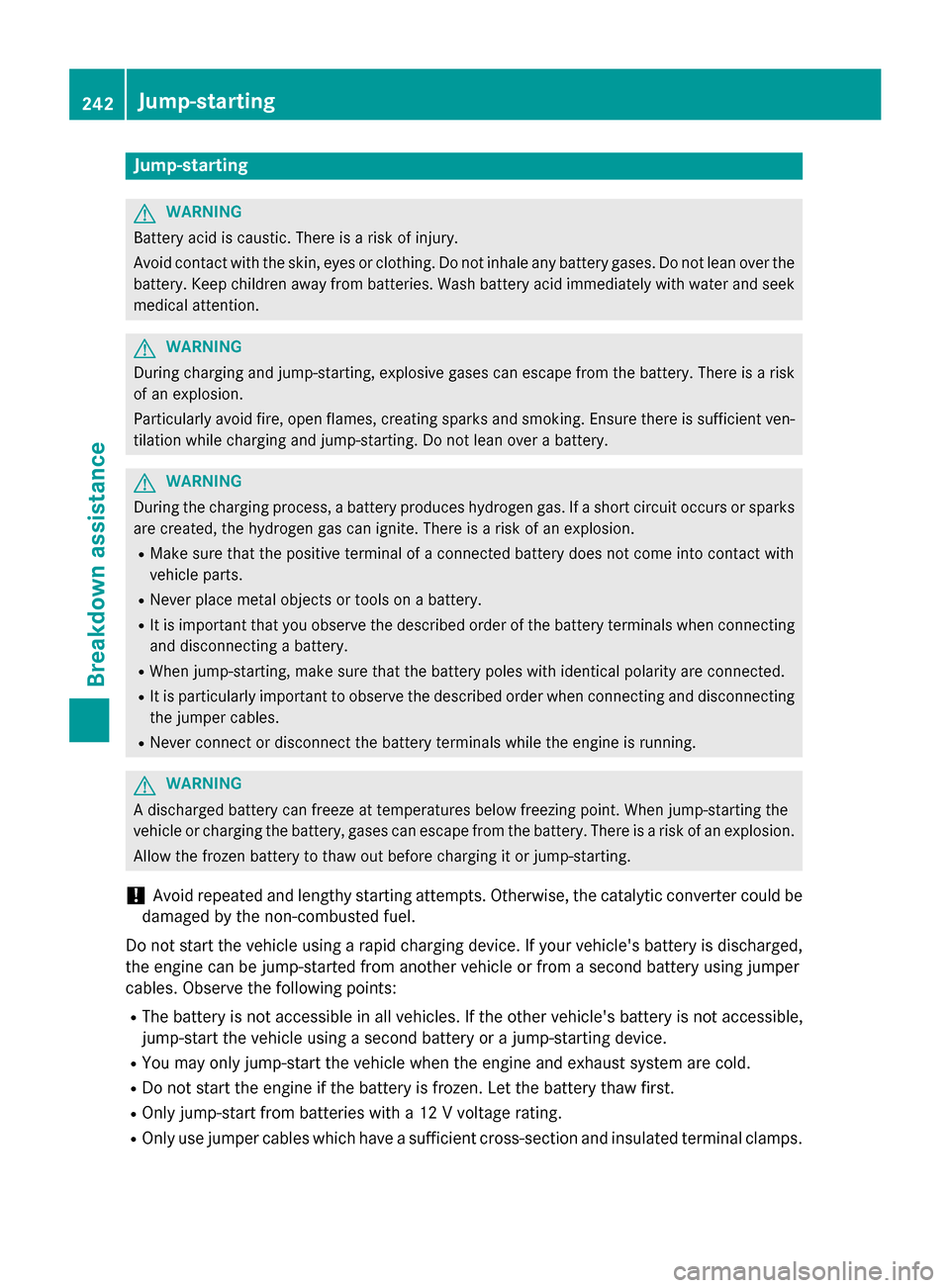
Jump-starting
G
WARNING
Battery acid is caustic. There is arisk of injury.
Avoid contact with the skin, eyes or clothing. Do not inhale any battery gases. Do not lean over the battery. Keep children away from batteries. Wash battery acid immediately with water and seek
medical attention. G
WARNING
During charging and jump-starting, explosive gases can escape from the battery. There is arisk
of an explosion.
Particularly avoid fire, open flames, creating sparks and smoking. Ensure there is sufficient ven-
tilation while charging and jump-starting. Do not lean over abattery. G
WARNING
During the charging process, abattery produces hydrogen gas. If ashort circuit occurs or sparks
are created, the hydrogen gas can ignite. There is arisk of an explosion.
R Make sure that the positive terminal of aconnected battery does not come into contact with
vehicle parts.
R Never place metal objects or tools on abattery.
R It is important that you observe the described order of the battery terminals when connecting
and disconnecting abattery.
R When jump-starting, make sure that the battery poles with identical polarity are connected.
R It is particularly important to observe the described order when connecting and disconnecting
the jumper cables.
R Never connect or disconnectt he battery terminals while the engine is running.G
WARNING
Ad ischarged battery can freeze at temperatures below freezing point. When jump-starting the
vehicle or charging the battery, gases can escape from the battery. There is arisk of an explosion.
Allow the frozen battery to thaw out before charging it or jump-starting.
! Avoid repeated and lengthy startinga
ttempts. Otherwise, the catalytic converter could be
damaged by the non-combusted fuel.
Do not start the vehicle using arapid charging device. If your vehicle's battery is discharged,
the engine can be jump-started from another vehicle or from asecond battery using jumper
cables. Observe the following points:
R The battery is not accessible in all vehicles. If the other vehicle's battery is not accessible,
jump-start the vehicle using asecond battery or ajump-starting device.
R You may only jump-start the vehicle when the engine and exhaust system are cold.
R Do not start the engine if the battery is frozen.L et the battery thaw first.
R Only jump-start from batteries with a12Vvoltage rating.
R Only use jumper cables which have asufficient cross-section and insulated terminal clamps. 242
Jump-startingBreakdown assistance
Page 252 of 290

Useful information
i This Operator's Manual describes all
models and all standard and optional equip- ment of your vehicle available at the time of
publication of the Operator's Manual.
Country-specific differences are possible.
Please not ethat your vehicle may not be
equipped with all feature sdescribed. This
also applies to safety-related system sand
functions.
i Please read the information on qualified
specialist workshops (Y page 23).Important safet
ynotes G
WARNING
If wheels and tires of the wrong size are used, the wheel brakes or suspensio ncomponents
may be damaged. There is arisk of an acci-
dent.
Always replace wheels and tires with those
that fulfill the specification softhe original
part.
When replacin gwheels, make sure to use the
correct:
R designation
R model
When replacin gtires ,make sure to use the
correct:
R designation
R manufacturer
R model G
Warning
Af lat tire severely impairs the driving, steer-
ing and brakin gcharacteristic softhe vehicle.
There is arisk of an accident.
do not drive with aflat tire. Immediately
replace the flat tire with your spare wheel, or
consult aqualified specialist workshop.
Accessories that are not approved for your
vehicle by Mercedes-Benz or that are not being used correctly can impair the operating
safety.
Before purchasin gand using non-approved
accessories, visit aqualified specialist work-
shop and inquire about:
R suitability
R legal stipulations
R factory recommendations
Information on dimensions and types of
wheels and tires for your vehicle can be found (Y page 275).
Information on air pressure for the tires on
your vehicle can be found:
R on the vehicle' sTire and Loading Informa-
tion placard on the B-pillar
R on the tire pressure label on the fuel filler
flap
R under "Tire pressure"
i Further information on wheels and tires
can be obtained at any qualified specialist
workshop. Operation
Information on driving
R If the vehicle is heavily loaded, chec kthe
tire pressures and correct them if neces-
sary.
R While driving, pay attention to vibrations,
noises and unusual handling characteris-
tics, e.g. pulling to one side. This may indi- cate that the wheels or tires are damaged.If you suspect that atire is defective,
reduce your speed immediately. Stop the
vehicle as soon as possible to chec kthe
wheels and tires for damage. Hidden tire
damage could also be causing the unusual
handling characteristics. If you find no
signs of damage, have the wheels and tires checked at aqualified specialist workshop.
R When parkin gyour vehicle, make sure that
the tires do not get deformed by the curb or
other obstacles. If it is necessary to drive
over curbs, speed humps or similar eleva- 250
OperationWheels and tires
Page 256 of 290
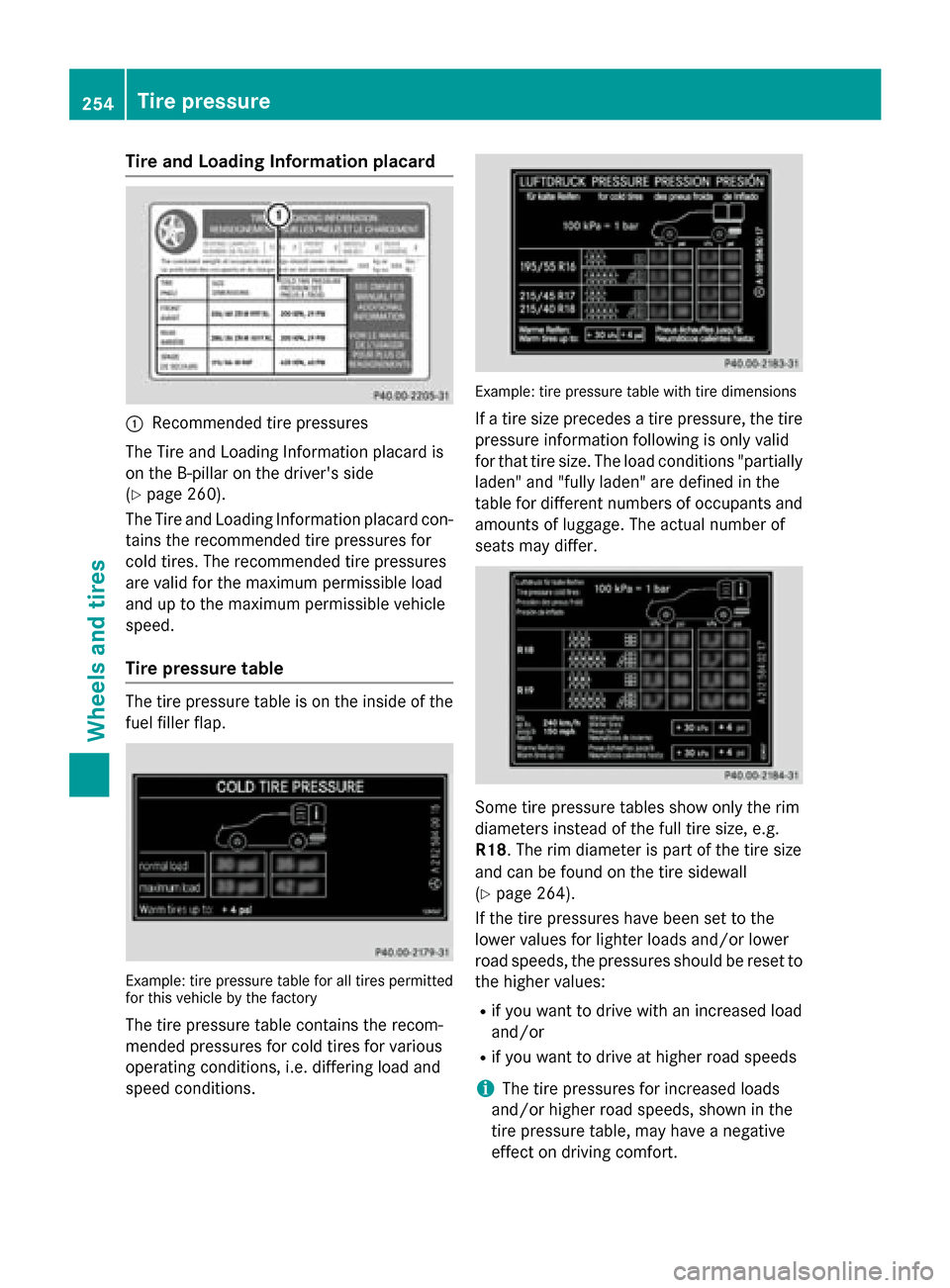
Tire and Loadin
gInfor matio nplacard 0043
Recommended tire pressures
The Tire and Loading Informatio nplacard is
on the B-pillar on the driver's side
(Y page 260).
The Tire and Loading Informatio nplacard con-
tains the recommende dtire pressures for
col dtires. The recommende dtire pressures
ar ev alid for the maximum permissibl eload
and up to the maximum permissibl evehicle
speed.
Tire pressure table The tire pressure table is on the insid
eofthe
fuel fille rflap. Example: tire pressure table for al
ltire sp ermitted
for thi svehicl ebyt he factory
The tire pressure table contains the recom-
mended pressures for col dtiresfor various
operating conditions, i.e .differing load and
spee dconditions. Example: tire pressure table with tire dimensions
If at ire size precedes atire pressure, the tire
pressure informatio nfollowing is onl yvalid
for tha ttire size. The load conditions "partially
laden" and "fully laden" ar edefine dint he
table for different numbers of occupants and
amounts of luggage. The actual numbe rof
seats ma ydiffer. Some tire pressure table
sshowo nlyt he rim
diameters instea dofthe full tire size, e.g.
R18 .The rim diamete rispartoft he tire size
and can be found on the tire sidewall
(Y page 264).
If the tire pressures have been se ttothe
lowe rvalues for lighte rloads and/or lower
roa dspeeds, the pressures shoul dbereset to
the highe rvalues:
R if yo uwanttod rive with an increase dload
and/or
R if yo uwanttod rive at highe rroa ds peeds
i The tire pressures for increase
dloads
and/or highe rroa ds peeds, shown in the
tire pressure table ,mayhave anegative
effect on driving comfort. 254
Tire pressureWheel
sand tires
Page 257 of 290
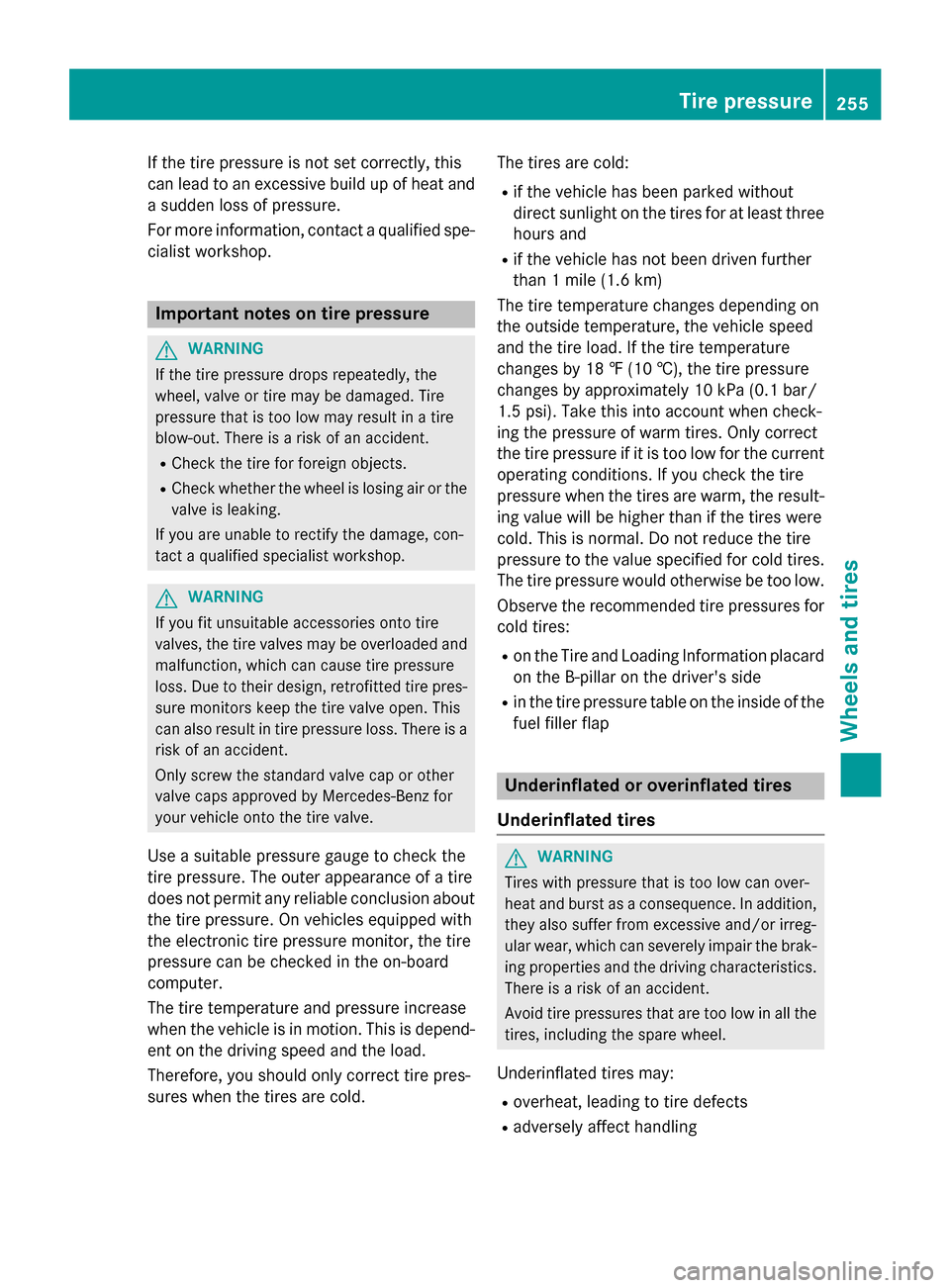
If the tire pressure is not set correctly, this
can leadtoane xcessive build up of heat and
as udden loss of pressure.
For more information, contact aqualified spe-
cialist workshop. Important notes on tire pressure
G
WARNING
If the tire pressure drops repeatedly,t he
wheel, valve or tire may be damaged. Tire
pressure that is too low may resultina tire
blow-out. There is arisk of an accident.
R Check the tire for foreign objects.
R Check whether the wheelisl osing air or the
valve is leaking.
If you are unabletor ectify the damage, con-
tact aqualifieds pecialist workshop. G
WARNING
If you fit unsuitable accessorie sonto tire
valves ,the tire valves may be overloaded and
malfunction, which can cause tire pressure
loss. Due to their design, retrofitted tire pres- sure monitors keep the tire valve open. This
can also resultint ire pressure loss. There is a
risk of an accident.
Only screw the standard valve cap or other
valve caps approved by Mercedes-Benz for
yourv ehicle onto the tire valve.
Use asuitable pressure gauge to check the
tire pressure. The outer appearance of atire
does not permit any reliable conclusion about the tire pressure. On vehicle sequippedw ith
the electronic tire pressure monitor, the tire
pressure can be checked in the on-board
computer.
The tire temperature and pressure increase
when the vehicle is in motion. This is depend-
ent on the driving speed and the load.
Therefore ,you shouldo nly correct tire pres-
sures when the tires are cold. The tires are cold:
R if the vehicle has been parked without
direct sunlight on the tires for at least three
hours and
R if the vehicle has not been driven further
than 1mile (1.6 km)
The tire temperature changes depending on
the outsid etemperature ,the vehicle speed
and the tire load. If the tire temperature
changes by 18 ‡(10 †), the tire pressure
changes by approximately 10 kPa (0.1 bar/
1.5 psi).T ake this into account when check-
ing the pressure of warm tires. Only correct
the tire pressure if it is too low for the current
operating conditions. If you check the tire
pressure when the tires are warm, the result- ing valuew illbeh igherthan if the tires were
cold. This is normal. Do not reduce the tire
pressure to the values pecified for cold tires.
The tire pressure would otherwis ebetoo low.
Observe the recommended tire pressures for
cold tires:
R on the Tire and Loading Information placard
on the B-pilla ronthe driver's side
R in the tire pressure table on the inside of the
fuel filler flap Underinflated or overinflated tires
Underinflated tires G
WARNING
Tires with pressure that is too low can over-
heat and burst as aconsequence. In addition,
they also suffer from excessive and/or irreg-
ularw ear, which can severel yimpair the brak-
ing propertie sand the driving characteristics.
There is arisk of an accident.
Avoid tire pressures that are too low in all the
tires, including the spare wheel.
Underinflated tires may:
R overheat, leading to tire defects
R adversely affect handling Tire pressure
255Wheelsand tires Z
Page 258 of 290
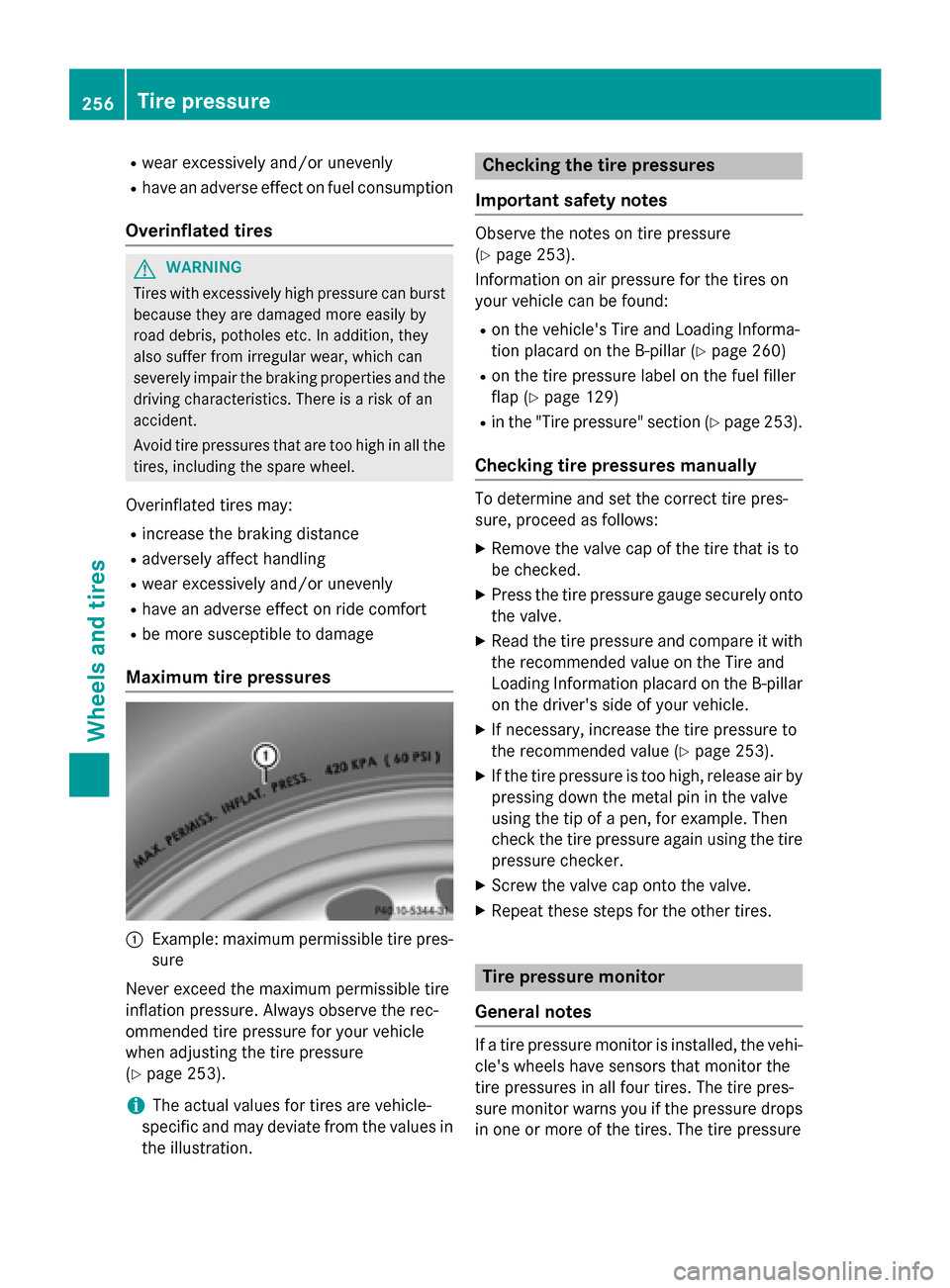
R
wear excessively and/or unevenly
R have an adverse effect on fuel consumption
Overinflated tires G
WARNING
Tires with excessively high pressure can burst
because they are damage dmoree asily by
road debris, potholes etc .Inaddition ,they
also suffer fro mirregular wear, whic hcan
severely impair th ebraking properties and the
driving characteristics. Ther eisarisk of an
accident.
Avoid tir epressures that are to ohigh in all the
tires, including th espare wheel.
Overinflated tires may: R increase th ebraking distance
R adversely affect handling
R wear excessively and/or unevenly
R have an adverse effect on ride comfort
R be mor esusceptible to damage
Maximum tir epressures 0043
Example: maximum permissible tir epres-
sure
Never exceed th emaximum permissible tire
inflatio npressure. Always observe th erec-
ommended tir epressure for your vehicle
when adjustin gthe tirep ressure
(Y page 253).
i The actual values for tires are vehicle-
specific and may deviat efromt hevalues in
th ei llustration. Checkin
gthe tirep ressures
Important safety notes Observe th
enotes on tir epressure
(Y page 253).
Information on air pressure for th etires on
your vehicle can be found:
R on th evehicle' sTire and Loadin gInforma-
tio np lacar dont heB-pillar (Y page 260)
R on th etirep ressure label on th efuel filler
flap (Y page 129)
R in th e"Tire pressure" sectio n(Ypage 253).
Checkin gtirep ressures manually To determine and set th
ecorrec ttirep res-
sure, proceed as follows:
X Remov ethe valve cap of th etiret hatisto
be checked.
X Pres sthe tirep ressure gauge securely onto
th ev alve.
X Read th etirep ressure and compare it with
th er ecommended value on th eTire and
Loadin gInformation placar dontheB-pillar
on th edriver' sside of your vehicle.
X If necessary, increase th etirep ressure to
th er ecommended value (Y page 253).
X If th etirep ressure is to ohigh, releas eair by
pressin gdown th emetal pin in th evalve
usin gthe tip of apen,for example. Then
check th etirep ressure again usin gthe tire
pressure checker.
X Screw th evalve cap ont othe valve.
X Repeat these steps for th eother tires. Tir
ep ressur emonitor
General notes If
at irep ressure monito risinstalled, th evehi-
cle' swheels have sensor sthatm onito rthe
tir ep ressures in all four tires. The tir epres-
sure monito rwarn syou if th epressure drops
in one or mor eofthetires. The tir epressure 256
Tir
ep ressureWheels and tires